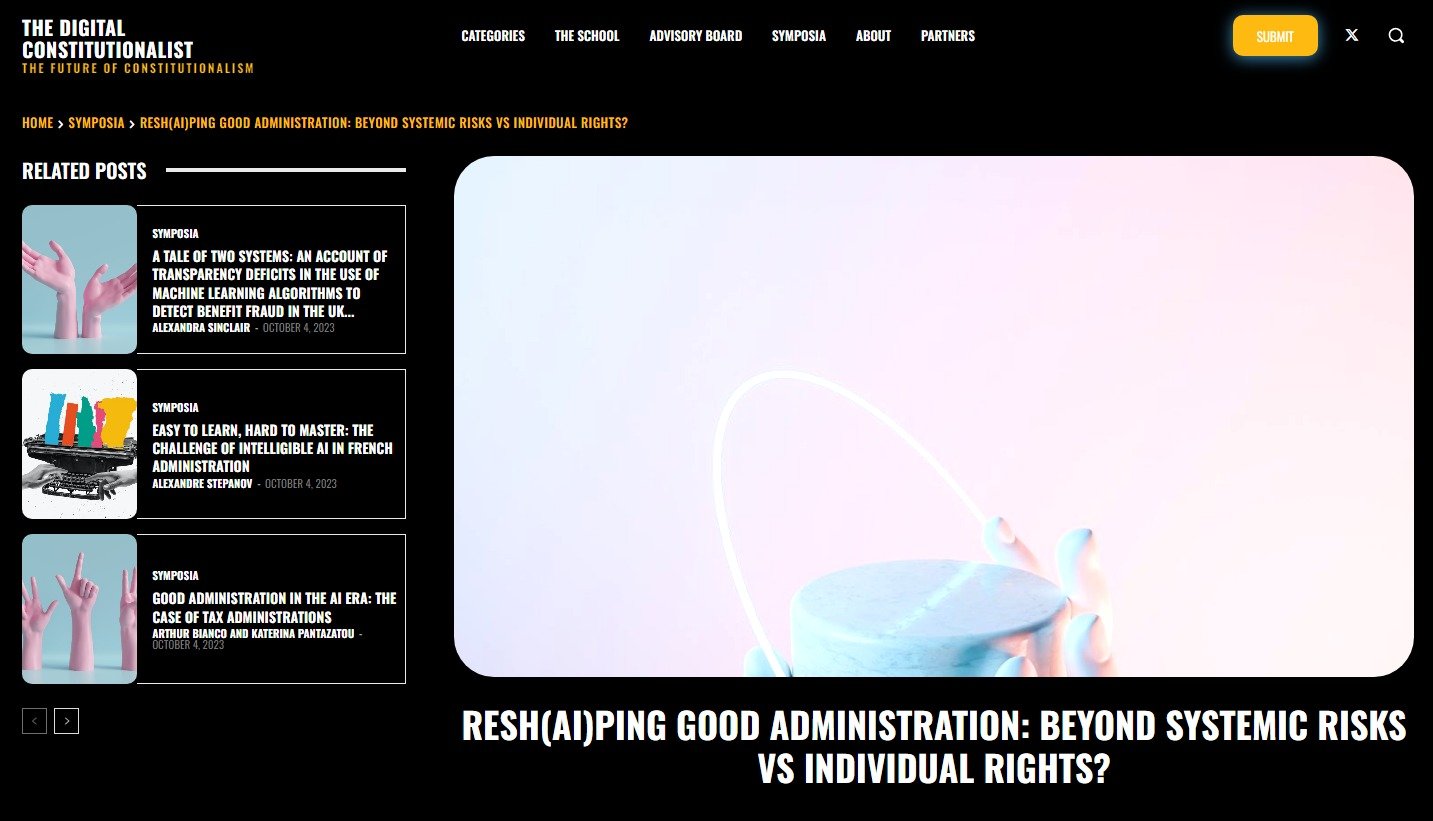Hanna Barakat & Archival Images of AI + AIxDESIGN / https://betterimagesofai.org / https://creativecommons.org/licenses/by/4.0/. The image depicts a series of stone-like hands, fractured and cracked, reaching out in various directions from a chaotic mass of tangled wires. Some hands display broken fingers, while archival tags on others suggest anonymity and erasure. The juxtaposition of human forms and technological wires evokes themes of labor, exploitation, and the often unseen physical work behind the tech industry.
In the aftermath of the CJEU’s Judgments in Kolin (C-652/22, EU:C:2024:910) and Qingdao (C-266/22, EU:C:2025:178), there was much anticipation about a guidance document being prepared by the European Commission to address some of the many, complex, consequential issues left open by the Court (see comment here).
The Q&A-type guidance document was published by the Commission late last week. The document has already been the object of analysis and deserved criticism, eg by Marko Turudić and Pedro Telles. They both comment on most aspects of the document in detail, and make good points.
In this post, I focus on two issues arising from the document and link them to first principles of procurement, as well as the broader layers of regulation beyond the EU.
two Extremely problematic assertions
In the Q&A document, the Commission makes two extremely problematic assertions. First, on the level of transparency to be afforded to decisions on participation and, if applicable, differential treatment of third country operators. Second, on the ‘severability’ of EU, national (and international) principles-based requirements.
Transparency requirements
The Q&A document states as follows:
Contracting authorities may indicate in advance in the tender documents their decision to accept or not participation of non-covered third country economic operators and, if they admit them, the arrangements applicable to their tenders.
They may also decide not to make this known in advance. In the absence of any reference to this matter in the contract notice / tender specifications, the contracting authority / entity still has the possibility to accept or to reject a tender from an economic operator from a non-covered country at any moment during the procurement process (answer to Q5.3, emphasis added).
‘Severability’ of legal principles by their ‘origin’
The Q&A document also states that:
Economic operators from non-covered countries do not enjoy any rights deriving from EU public procurement law, including requirements for transparency and proportionality enshrined in EU law and transposed into the national legal order. It is open to competent national authorities to identify other national provisions (not transposing EU public procurement law) on which such economic operators might rely (answer to Q6.2).
And that, in ensuring compliance with the principle of the rule of law ‘Contracting authorities/ entities may base themselves on national legislation that does not transpose EU law’ (answer to Q6.4) and, further, that ‘any possible issue of compliance with the ECHR would concern national law only and would be unrelated to any instance of implementation of EU law by a Member State’ (answer to Q6.5, emphasis added).
Overall position
Combined, this sets out the combined position that (i) contracting authorities can make decisions based on undisclosed criteria at any point in the procurement process and that (ii) any transparency, etc requirements in relation to those criteria or those decisions can only stem from domestic legislation not transposing EU public procurement law / unrelated to any instance of implementation of EU law.
The CJEU benchmark
A first issue is that, in my view, the Commission’s assertions only partially follow from the Kolin and Qingdao judgments. It is thus worth recalling what the CJEU said. In Kolin, the Court established that:
‘While it is conceivable that the arrangements for treatment of such operators should comply with certain requirements, such as transparency or proportionality, an action by one of those operators seeking to complain that the contracting entity has infringed such requirements can be examined only in the light of national law and not of EU law’ (C-652/22, para 66).
In Qingdao, the Court stated that:
‘While it is conceivable that those treatment arrangements should comply with certain principles and requirements, such as the principle of protection of legitimate expectations and of legal certainty, an action raising a complaint that the contracting authority has infringed those principles can be examined only in the light of national law and not of EU law’ (C-266/22, para 66).
an alternative (less questionable?) interpretation
As we can see, the CJEU did not establish any hard boundary on the relationship between the national and EU law rules containing reference to the principles of protection of legitimate expectations and of legal certainty, or (the requirements) of transparency and proportionality. The CJEU said that the principles as enshrined in EU law could not be relied on. An alternative, domestic source would be needed. The CJEU was (almost) clear in accepting that (it is conceivable that) arrangements for the treatment of third country economic operators had to comply with transparency, proportionality etc requirement, but not as a matter of EU law.
A modestly and sensibly creative interpretation of the CJEU judgments would thus seek not to exclude protection afforded by homonymous principles and requirements, whether they are enshrined in the exact same domestic rules or not, as long as the applicability of the principles had a justification in a legal source other than EU law. This is not the same as demanding that an entirely separate (formulation of the) principle (to the same effect) exists. It simply requires that there is an alternative source of the requirement to abide by the given principle or requirement.
And there are at least two such general sources. First, the United Nations’ Convention Against Corruption (UNCAC) offers one such source in requiring that ‘Each State Party …, in accordance with the fundamental principles of its legal system, take[s] the necessary steps to establish appropriate systems of procurement, based on transparency, competition and objective criteria in decision-making, that are effective, inter alia, in preventing corruption’, with a requirement for such systems to explicitly address issues of transparency, establishment in advance of conditions for participation, and access to an effective system of domestic review’ (Art 9.1). Second, the ECHR provides the right to fair trial (Art 6).
Such an approach would have allowed some space for Member States to continue complying with basic requirements of administrative law and procurement regulation while the mess created by the Kolin and Qingdao judgments gets sorted out through EU procurement legislation. Any arguments that such course of action would detract from the effet utile of EU law would seem destined to fail, given that the CJEU had already accepted that participation by third country operators was possible and that equal treatment was also possible—just not as a matter of EU law. The Kolin/Qingdao could have been bracketed as an issue of competence and the true effectiveness of the case law been pushed to the reform of the directives in a much less disruptive manner.
Conversely, the Commission’s extreme interpretation seeks to wipe out such space for manoeuvre in requiring that the source of law demanding certainty, protection of legitimate expectations, transparency or proportionality has nothing to do and is entirely unrelated with the transposition of EU law. This is an impossible threshold to cross, as there will be no jurisdiction that has a set of procurement legislation to implement EU law, another one to comply with UNCAC, another one to comply with the ECHR, etc.
In fact, as EU procurement law is itself adjusted to those international standards and requirements, the transposition of the EU directives has been the mechanism to ensure compliance with all these layers of procurement regulation. This is a situation that is simply impossible to unbundle. Suggesting otherwise verges on the irresponsible, as it places contracting authorities in a position to breach a wide array of international and domestic rules, as well as creating significant corruption risks.
Corruption risks
Setting issue of legal interpretation aside for a moment, perhaps the most problematic part of the Q&A document is the second paragraph of the answer to question 5.3, where the Commission indicates that contracting authorities may ‘decide not to make [their decision to accept or not participation of non-covered third country economic operators and, if they admit them, the arrangements applicable to their tenders] known in advance. In the absence of any reference to this matter in the contract notice / tender specifications, the contracting authority / entity still has the possibility to accept or to reject a tender from an economic operator from a non-covered country at any moment during the procurement process‘. Crucially, the European Commission forgot to open (or close) the sentence with the all important caveat that this is (at best) the position solely for the purposes of EU law.
In my view, there is no question that a contracting authority that decided to operate in this manner would be in breach of UNCAC and a variety of constitutional level provisions (regardless of the specific EU jurisdiction we want to focus on).
And, more importantly, a contracting authority that decided to behave in this manner would be exposing itself to potentially significant corruption risks. Lack of transparency and not formulating the criteria to be applied in procurement decision-making at the point of launching the procedure not only reserves the contracting authority unlimited discretion and thus triggers the risk of arbitrariness in decision-making. More problematically, it exposes key decision-makers to pressure and to risks of corruption — either by the ‘covered’ entities seeking to persuade it to exclude the tender/s by the third country operator/s, or by the latter seeking the opposite, or both.
the bigger picture
Ultimately, the Kolin/Qingdao saga and this Q&A show that we are at risk of losing sight of the bigger picture. Procurement rules are not only, or even primarily, about trade liberalisation. They are essential tools of good governance and a source of discipline and integrity in the expenditure of public funds. Given their importance, multiple layers of procurement regulation are overlaid and, while they vary in their details, they all share the same core principles and fundamentals. Seeking to deviate from these, or to limit them to one and only one of those layers of regulation can simply not work.
It should also be clear that, as a matter of bigger picture, the inconvenience that sometimes comes from complying with the rule of law and other constitutional-level guarantees should possibly create constraints and difficulties in the implementation and rollout of EU (common) policy, as it does at national level. The Kolin/Qingdao saga and this Q&A can only be read as a prioritisation of the common commercial policy over good administration and rule of law considerations. It does not paint a pretty picture and it does not signal a particularly strong commitment to one of the fundamental values of the Union, to be frank.
The bigger picture is too that the CJEU had (at least) two ways of addressing these issues. One would be to impose a full ban on participation by non-covered third country operators. The other would be to have been more accepting of the limitations of ‘policy-making by judgment’ and to have openly stated that, once a third country operator has not been excluded, legal protections follow. By setting such shaky foundations as the Kolin/Qingdao case law, the CJEU enables the European Commission to make unhelpful interventions such as this one. The other part of the bigger picture is, as well, that the European Commission is willing to take exactly zero risks and that, in this extreme risk aversion, it can come to exacerbate problems arising from the case law.



















